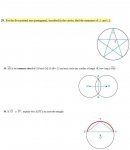These are three new ones. I think I have the answers, but I thought I would run it by here first. (these are straight out of the textbook, so lets just say its 1-3 going from top to bottom)

1. In the center is a pentagon with five sides. the sum of the interior angles is (number of sides-2)*180. in this case, that means 540 is the total number sum for all angles. so to get the angle for 2, we just state m∠2=540/5=108. this is supplementary to the angle next to the angle above it closer to angle 1. this means this angle (lets say angle x) =180-108=72. since angle 2 is 108 in this pentagon, that means that the angle adjacent to it is congruent, which means the second base angle is also congruent (call this angle y). this means in that one triangle, both base angles are congruent at 72 (also making it an isosceles triangle). since the sum measurements of all angles in a triangle is 180, we can state that ∠1+∠x+∠y=180. using substitution: ∠1+72+72=180; ∠1+144=180; ∠1=36. thus the measurements for angle 1 and angle 2 are 36 and 108.
2 I created lines OA and OQ in an attempt to make a triangle out of the crossed lines, and added point Z for the intersection of each line. since radius is equal all around, the measurement of each line is 10. since line AB is perpendicular to line OQ, these new lines help create a right triangle for each side. this means the Pythagorean theorem can be used. I think there is a way to prove that line AZ is one half of line AB and thus AZ=6. using this, we just have to solve a²+6²=10². when you do this math, it states that a (or line QZ) equals 8. meaning that 1/2 of line QO is 8 so QO=16.
3can assume that each angle of the triangles that is an intercepted triangle is equal to 1/2 the base arc. so if arc st is congruent with arc TV then angle TSV is congruent with angle TVS and are also 1/2 the arcs they are based off of. The base angles for an isosceles are congruent, thus triangle TSV is an isosceles triangle.
I thought about this hard, and if anyone see's any flaws let me know ok?

1. In the center is a pentagon with five sides. the sum of the interior angles is (number of sides-2)*180. in this case, that means 540 is the total number sum for all angles. so to get the angle for 2, we just state m∠2=540/5=108. this is supplementary to the angle next to the angle above it closer to angle 1. this means this angle (lets say angle x) =180-108=72. since angle 2 is 108 in this pentagon, that means that the angle adjacent to it is congruent, which means the second base angle is also congruent (call this angle y). this means in that one triangle, both base angles are congruent at 72 (also making it an isosceles triangle). since the sum measurements of all angles in a triangle is 180, we can state that ∠1+∠x+∠y=180. using substitution: ∠1+72+72=180; ∠1+144=180; ∠1=36. thus the measurements for angle 1 and angle 2 are 36 and 108.
2 I created lines OA and OQ in an attempt to make a triangle out of the crossed lines, and added point Z for the intersection of each line. since radius is equal all around, the measurement of each line is 10. since line AB is perpendicular to line OQ, these new lines help create a right triangle for each side. this means the Pythagorean theorem can be used. I think there is a way to prove that line AZ is one half of line AB and thus AZ=6. using this, we just have to solve a²+6²=10². when you do this math, it states that a (or line QZ) equals 8. meaning that 1/2 of line QO is 8 so QO=16.
3can assume that each angle of the triangles that is an intercepted triangle is equal to 1/2 the base arc. so if arc st is congruent with arc TV then angle TSV is congruent with angle TVS and are also 1/2 the arcs they are based off of. The base angles for an isosceles are congruent, thus triangle TSV is an isosceles triangle.
I thought about this hard, and if anyone see's any flaws let me know ok?
